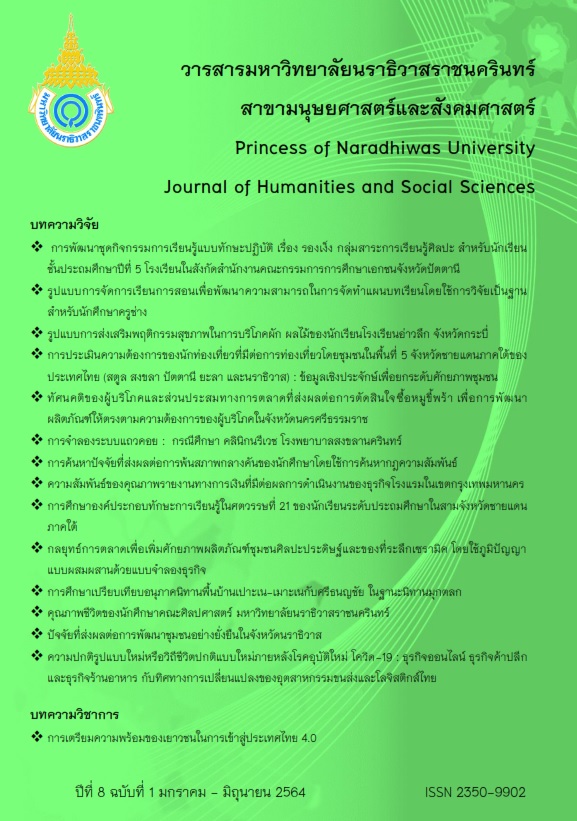Marketing Strategies to Increase Potential of Community Products: Artificial Arts and Ceramic Souvenirs using Integrated Wisdom with Business Models
Main Article Content
Abstract
This research objective was to study guidelines and marketing strategies to increase potential of community products; artificial arts and ceramic souvenirs, by integrating wisdom with business models. This was qualitative research using descriptive statistics to analyze data. The structure interview form was used to collect data for in-depth interviews. The group targets were 42 OTOP (artificial arts and souvenirs) entrepreneurs in 14 southern provinces. Each interview question was verified its content validity, and received overall IOC at 0.66.
The research results found that guidelines to increase potential of community products; OTOP artificial arts and ceramic souvenirs by integrated wisdom with business models divided into two ways: 1) develop groups of entrepreneur and 2) develop product selection criteria. The strategies to increase potential of the community products by integrated wisdom with business model canvas included 6 strategies: 1) market share strategy; target customers, 2) brand value building strategy; having product story, 3) marketing strategy focusing on contents, 4) bee buzz strategy, 5) sale promotion strategy and 6) product differentiation strategy.
Article Details

This work is licensed under a Creative Commons Attribution-NonCommercial-NoDerivatives 4.0 International License.
References
กนกวรรณ ไทยประดิษฐ, และฐะปะนีย์ ตรีรัตนภรณ์. (2559). เครือข่ายสังคมค้าขายออนไลน์:คุณลักษณะของความต่างที่เป็นตัวเลือกระหว่างเฟชบุ๊ก ไลน์ และอินสตาแกรม. วารสาร นักบริหาร, 36(2), 24-38.
กรมการพัฒนาชุมชน กระทรวงมหาดไทย. (2558). คู่มือการดำเนินงานผู้ผลิต ผู้ประกอบการ OTOP รายใหม่ประจำปี 2558. กรุงเทพฯ: บีทีเอส เพรส.
ฉัตรชัย อินทสังข์. (2554). เอกสารการสอนหลักการตลาด. นครราชสีมา: มหาวิทยาลัยเทคโนโลยีราชมงคลอีสาน.
นพรัตน์ ภูมิวุฒิสาร. (2556). การจัดการการตลาด. กรุงเทพฯ: จุฬาลงกรณ์มหาวิทยาลัย.
ปราณี หลําเบ็ญสะ. (2561). การวัดผลและประเมินผลการศึกษา. กรุงเทพฯ: สหมิตรพัฒนาการพิมพ์ (1992).
ปรารถนา รุกขชาติ. (2559). ภาพลักษณ์ตราสินค้า OTOP และการสร้างตราสินค้า น้ำพริกกุ้งกรอบ ที่มีอิทธิพลต่อปัจจัยทางการตลาดของผู้ประกอบการในจังหวัดชลบุรี (วิทยานิพนธ์ปริญญามหาบัณฑิต). มหาวิทยาลัยบูรพา, ชลบุรี.
วรรณา ต.แสงจันทร์, และปราณี จันทร์ลา. (2554). การศึกษาสมบัติของดินขาวนราธิวาส. วารสารกรมวิทยาศาสตร์บริการ, 59(185), 37-40.
วสันต์ ธีระพิทยานนท์. (2558). การถ่ายทอดเทคโนโลยีเซรามิกสู่ชุมชน. สืบค้น 22 กุมภาพันธ์ 2563, จาก http://lib3.dss.go.th/fulltext/dss_j/2549_54_170_P30_33.pdf
ศิริวรรณ เสรีรัตน์. (2553). การบริหารการตลาดยุคใหม่. กรุงเทพฯ: สำนักพิมพ์พัฒนาศึกษา. สถาบันการอาชีวะภาคเหนือ. วิทยาลัยการอาชีพเทิง.
ศรีสุดา ลีลาสุวัฒน์. (2558). แนวทางการพัฒนาการตลาดสินค้า OTOP สู่สากล อำเภอสามพราน จังหวัดนครปฐม. กรุงเทพฯ: มหาวิทยาลัยเทคโนโลยีราชมงคลรัตนโกสินทร์ สถาบันวิจัยและพัฒนา.
สุภัสสร ศรีมนตรี, และภิเษก ชัยนิรันดร์. (2558). ปัจจัยที่ส่งผลต่อความภักดี ของลูกค้าในพาณิชย์อิเล็กทรอนิกส์. วารสารวิทยาลัยบัณฑิตศึกษาการจัดการ มหาวิทยาลัยขอนแก่น, 8(2),151-166.
สุภางค์ จันทวานิช. (2551). วิธีการวิจัยเชิงคุณภาพ (พิมพ์ครั้งที่ 16). กรุงเทพฯ: สำนักพิมพ์แห่งจุฬาลงกรณ์มหาวิทยาลัย.
เสริมยศ ธรรมรักษ์. (2556). สร้างเสน่ห์ สร้างคุณค่าให้แบรนด์เพื่อก้าวสู่ประชาคมเศรษฐกิจอาเซียน. วารสารนักบริหาร, 33(2), 17-25.
โสภณ เสรีเสถียรทรัพย์, และเนาวนิตย์ สงคราม. (2559). การพัฒนารูปแบบการเรียนรู้โมเดลธุรกิจด้วยเทคนิคการตั้งคำถาม 5W1H ร่วมกันบนเว็บเพื่อส่งเสริมความสามารถในการคิดวิเคราะห์สำหรับนิสิตนักศึกษาระดับปริญญาบัณฑิต. วารสารอิเล็กทรอนิคส์ทางการศึกษา, 11(3), 102-118.
สำนักหอสมุดและศูนย์สารสนเทศวิทยาศาสตร์และเทคโนโลยี. (2563). การพัฒนาผลิตภัณฑ์เซรามิก. ฐานข้อมูลส่งเสริมและยกระดับคุณภาพสินค้า OTOP. สืบค้น 24 มิถุนายน 2563, จาก http://otop.dss.go.th/index.php/en/knowledge/Informationerpack/359-2020-01-24-08-42-46?showall=&start=8
ออสเทอร์วัลเดอร์, เอ., และพินเญอร์, วาย. (2557). คู่มือสร้างโมเดลธุรกิจสำหรับผู้มองการณ์ไกล ผู้คิดจะทำการใหญ่และผู้หวังจะล้มยักษ์ [Business model generation] (วิญญู กิ่งหิรัญวัฒนา, ผู้แปล). กรุงเทพฯ: วีเลิร์น.
Kotler, P., & Armstrong, G. (2010). Principles of Marketing (13th edition). New Jersey, USA: Pearson Education Inc.


